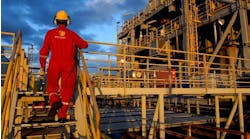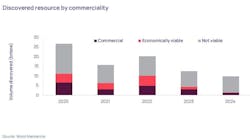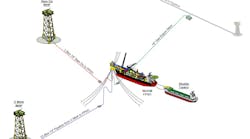Full-scale data comparison for the Red Hawk cell spar in Hurricane Rita and Loop Current Ulysses
The 18th Annual Deep Offshore Technology International Conference & Exhibition offers a line-up of innovative technology solutions and lessons learned to promote exploration, development, and production of oil and gas in deep and ultra deepwater basins around the world.
DOT has earned its recognition as the leading forum for real-world project examples from frontier areas, marginal field developments, flowlines and pipelines, and risk and reliability, among many other topics, through its commitment to selecting high-quality papers to anchor the conference.
From Nov. 28-30 at the George R. Brown Convention Center in Houston, Texas, three tracks of presentations will run concurrently: floaters/construction; subsea/flow assurance; and well construction/risk.
This year special emphasis has been placed on the topic of well construction. The closing session will present thoughts on attracting new talent in sufficient numbers to keep pace with the attrition associated with an aging workforce.
This section presents a preview of selected papers from each of the DOT tracks, only a sampling from the more than 90 presentations included in the conference program.
Sampath Atluri, Jim Maher,, Himanshu Gupta - Technip USA
Jenifer Tule, Matt Lamey - Anadarko Petroleum Corp.
This paper, to be presented in the floaters/construction track, discusses how the Red Hawk cell spar’s platform instrumentation system maintained high-quality readings during the entire buildup and decay of Hurricane Rita, providing information for calibration of many of the design methods typically used for spar platforms.
Red Hawk is the third generation spar installed in the GoM and is classified as a cell spar. A cell spar hull is composed of a bundle of cylindrical members called cells that are held together by a number of horizontal and vertical structural elements located in the interstitial space between the cells. Red Hawk field spans Garden Banks blocks 876 and 877 and is operated by Anadarko (previously Kerr Mc-Gee). The spar was installed in mid-2004 in 5,300 ft of water. Six mooring lines were used to anchor the spar. The accompanying table summarizes its hull and mooring configuration.
Typical cell spar.
A comprehensive instrumentation package was installed on the spar to measure responses as well as the environment. Of particular interest is the six-degree of freedom motion package (accelerometers and angular rate sensors) positioned at cellar deck, differential global positioning system, horizontal and vertical current profilers, air gap sensors (wave measurement), and wind anemometers. The instrumentation system measured motions and environments during several extreme events at the Red Hawk field in the past two years.
Field motion data analysis forRed Hawk during Hurricane Rita and Eddy Ulysses is presented, and the field data acquired during Hurricane Rita are compared with the predicted motions under the same environments. The performance of Red Hawk cell spar is consistent with the predictions.
Simulation of spar motion is done using MLTSIM, a nonlinear time domain software developed for modeling hydrodynamic response of floating platforms. A one-hour average speed and direction of wind and current measured are used for input. The mean wind speed measured at crane (120 ft from water level) is corrected for 30 ft elevation, which is a requirement in MLTSIM (similar to API standards). For a given one-hour mean wind speed, MLTSIM synthesizes a wind spectrum assuming the API2A spectral shape. For wave input, the spectrum of the measured wave is directly used and wave direction is calculated from dynamic pitch and roll data.
The authors present details of the Hurricane Rita field data analysis that include:
- Response measurement of the spar
- Surge comparison
- Tilt comparison
- Heave comparison
- Mooring tension measurements.
Eddy Ulysses field data analysis includes calculation of offset standard deviations for each one-hour measurement for a two-month period. The methodology used will be discussed during the presentation.
The authors conclude:
- TheRed Hawk spar essentially is responding as predicted. The maximum measured tilt is 8.8 degrees and maximum measured offset is about 162 ft. The 100-year hurricane design maxima are 11 degrees and 200 ft, respectively.
- The chain-polyester mooring system is proved to be robust.
- Red Hawk field measurements have been analyzed extensively for the Ulysses Eddy event experienced from December 2004 to January 2005 using a methodology that has been demonstrated to rely on high-quality data using a conservative calibration method.
- Derived data from Ulysses shows no significant vortex-induced motion (VIM) during two months of lock-in condition. Some lock-in events were observed, but VIM performance was excellent and significantly better than model test predictions.
| Item | Value |
|---|---|
| Hull Configuration | |
| Cell diameter (ft) | 20 |
| Hull length (ft) | 560 |
| Hull draft (ft) | 510 |
| Hard tank length (ft) | 280 |
| Leg length (ft) | 280 |
| Heave plate number | 4 |
| Heave plate equivalent diameter (ft) | 64 |
| Mooring Configuration | |
| Mooring line number | 6 |
| Chain diameter (in) | 4.5 |
| Chain length (ft) | 955 |
| Chain breaking strength w/ 8mm corrosion (kips) | 2,440 |
| Rope diameter (in) | 8.5 |
| Rope length (ft) | 7,030 |
| Rope breaking strength (kips) | 2,750 |
| Topside weight | |
| Initial (s.t.) | 3,800 |
| Future (s.t. | 4,700 |




